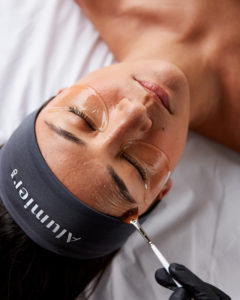Are you struggling with rosacea and seeking effective treatments to restore the natural beauty of your skin? Look no further! In this blog post, we’ll explore the causes and aggravating factors of rosacea while shedding light on the potential benefits of two innovative treatments: Platelet-Rich Plasma (PRP) and injectable vitamins. Let’s delve into the world of rosacea treatments and discover skin-calming practices to help you deal with outbreaks for a renewed sense of confidence.

Understanding Rosacea
Rosacea is a chronic inflammatory skin condition that primarily affects the face. It is characterised by redness, flushing, visible blood vessels, and sometimes small bumps or pustules. While the exact cause of rosacea remains unknown, several factors have been identified as potential triggers and contributors to its development. Additionally, treatments for rosacea can vary in effectiveness, and dietary choices may play a role in managing the condition. Let’s delve into these aspects to gain a comprehensive understanding. Rosacea is a chronic skin condition that affects millions of individuals worldwide. While its exact cause remains unknown, certain triggers and factors contribute to the development and aggravation of rosacea. These include genetic predisposition, environmental factors and increased blood vessel reactivity. Understanding these causes empowers us to explore effective treatments.
Causes of Rosacea
The precise cause of rosacea is still not fully understood. However, certain factors have been associated with the development and exacerbation of the condition:
- Genetic Predisposition: A family history of rosacea can increase the likelihood of developing the condition.
- Abnormalities in the Blood Vessels: Blood vessels in the skin may be more reactive or dilated in individuals with rosacea, leading to redness and flushing.
- Immune System Dysfunction: An inappropriate immune response and chronic inflammation are thought to contribute to the development of rosacea.
- Demodex Mites: The presence of microscopic mites called Demodex on the skin may play a role in triggering or aggravating rosacea in some individuals.
- Environmental Factors: Exposure to sunlight, extreme temperatures, wind, and certain chemicals can trigger or worsen rosacea symptoms.
- Smoking and alcohol consumption. Both these practices dilate blood vessels and weaken the integrity of your skin structure, especially the fine skin on the face.
Aggravating Factors and Skin-Calming Practices
To effectively manage rosacea, it’s crucial to identify and minimize aggravating factors. Common triggers include exposure to sunlight, extreme temperatures, spicy foods, alcohol, and certain skincare products. By incorporating skin-calming practices into your daily routine, such as using gentle cleansers, avoiding harsh exfoliants, and wearing broad-spectrum sunscreen, you can significantly reduce the frequency and severity of rosacea outbreaks. Additionally, practicing stress management techniques, like meditation or yoga, can help reduce stress-induced flare-ups.
Dealing with Rosacea Outbreaks
Despite our best efforts, occasional rosacea outbreaks can occur. During these times, it’s important to know how to manage the symptoms effectively. Applying cool compresses, using anti-inflammatory creams or gels recommended by your dermatologist, and avoiding triggers can help alleviate redness and discomfort. Remember, maintaining a positive mindset is essential in dealing with rosacea outbreaks. By focusing on the treatments that work for you, you can regain control over your skin’s health and appearance.
The Role of Diet in Rosacea
Dietary choices may influence the severity of rosacea symptoms in some individuals. While there is no universally applicable “rosacea diet,” certain food and drink choices have been reported to trigger flare-ups in some people. These triggers can vary from person to person, but common culprits include:
- Spicy Foods: Hot peppers, chili powder, and spicy seasonings have been known to cause flushing and increased redness in some individuals.
- Alcohol: Red wine, beer, and certain spirits have been linked to increased rosacea symptoms, likely due to their ability to dilate blood vessels.
- Hot Beverages: Hot coffee, tea, and other hot drinks may trigger flushing and worsen rosacea symptoms.
- Histamine-Rich Foods: Some individuals with rosacea may be sensitive to foods high in histamine, such as aged cheeses, fermented foods, and cured meats.
- Food Allergens: Certain individuals may have specific food sensitivities or allergies that can exacerbate rosacea symptoms.
It’s important to note that dietary triggers can vary significantly from person to person. Keeping a food diary and noting any patterns between certain foods and symptom flare-ups can help identify personal triggers. Consultation with a healthcare professional, such as a dermatologist or registered dietitian, can provide valuable guidance and help develop a personalized dietary plan to manage rosacea.
Rosacea Treatments
Treatment options for rosacea focus on managing symptoms and reducing inflammation. However, the effectiveness of treatments can vary depending on individual factors. Here’s a look at some commonly used treatments:
- Topical Medications: Prescription creams or gels containing antibiotics, azelaic acid, or sulfur can be effective in reducing inflammation and controlling symptoms.
- Oral Medications: In more severe cases, oral antibiotics like doxycycline or isotretinoin may be prescribed to alleviate symptoms.
- Laser and Light Therapies: These treatments can target visible blood vessels, reduce redness, and improve overall skin appearance.
- Avoiding Triggers: Identifying and avoiding triggers like spicy foods, alcohol, certain skincare products, and extreme temperatures can help minimize flare-ups.
- Stress Management: Stress is a common trigger for rosacea outbreaks, so adopting stress-reduction techniques like exercise, meditation, and relaxation exercises can be beneficial.
While the aforementioned treatments are often effective, it’s important to note that not all individuals respond the same way. What works for one person may not work for another. It’s crucial to consult with Wimblederm to determine the best treatment plan tailored to your specific needs.

The Potential of PRP Treatments
One of the emerging treatments for rosacea is Platelet-Rich Plasma therapy. PRP involves using your own blood, which is rich in platelets and growth factors, to stimulate the skin’s natural healing processes. When injected into the affected areas, PRP can help reduce inflammation, promote collagen production, and improve overall skin texture. Many patients have reported significant improvements in their rosacea symptoms after undergoing PRP treatments. We have many patients with excellent long lasting rosacea reduction following PRP treatments.
Harnessing the Power of Injectable Vitamins
Another promising approach in rosacea treatment involves intradermal injectable vitamins. These specialized injections deliver essential vitamins, such as vitamin C and vitamin B-complex, directly into the affected areas of the skin. These vitamins possess powerful antioxidant properties, which can help neutralize free radicals and reduce inflammation. This treatment method has shown great potential in minimizing redness, soothing irritated skin, and improving overall skin health.
Both PRP and vitamin mesotherapy treatments are available at Wimblederm. Treatments come with advice on an advanced homecare regime to keep rosacea at bay.
Rosacea can be challenging, but with the right knowledge and treatments, you can achieve a clearer, more radiant complexion. PRP therapy and intradermal injectable vitamins offer exciting possibilities for rosacea management, providing long-lasting relief and rejuvenation. By understanding the causes and triggers of rosacea, adopting skin-calming practices, and staying positive, you can effectively deal with outbreaks and regain your self-confidence. Consult with Wimblederm to explore these innovative treatments and embark on a journey towards healthier, more vibrant skin.
Remember, you deserve to look and feel your best!
Written By: Bhavash Padhiar | Wellness Blogger
Facebook: @wimblederm
Instagram: @wimblederm
Twitter: @bhavashmedical






